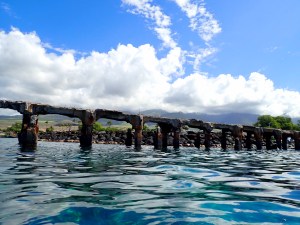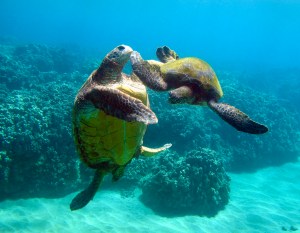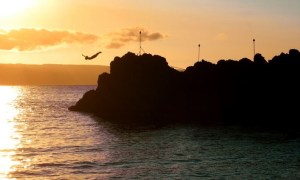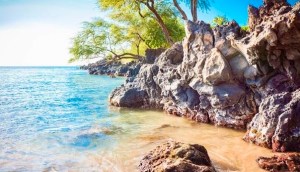Maui Shore Diving Guide

Scuba diving in Maui has become a popular island activity for beginner and certified divers. In particular, Maui shore diving tours consistently rank Top 5 on TripAdvisor. Why? Because you can access the best dive sites from the beach, especially in Lahaina and Kaanapali! So skip the boat and find vibrant coral reefs, turtles, and White Tip Reef Sharks along Maui’s shoreline.
Lahaina features enticing dive sites with excellent ocean conditions for all comfort and experience levels. The ocean surrounding West Maui has clear visibility, warm temperatures, and shallow depths. Your Maui scuba diving journey begins here. We explain the popular dive sites, what you can expect to see, and safety tips for courteous shore diving in Maui.
Scuba Diving in Maui
Airport Beach (Kahekili Beach Park)

Located in front of the Westin Kaanapali Ocean Resorts Villas is a long stretch of fringing coral reefs along the sandy coastline. Known as Airport Beach or Kahekili Beach Park, many scuba companies visit this spot to shore dive. Here the coral reef begins as soon as you enter the ocean. So you do not have to make a long surface swim to start your dive. Twenty-five feet from the beach a shallow sandy channel makes for a perfect setting to teach scuba diving lessons or refresh with a scuba review. At the edge of the dive site, hidden coral heads full of fish exist at 50 to 80 feet, making this site incredibly versatile for different levels of scuba diving experience.
Dive conditions at Airport Beach consistently rate as excellent during the summer months of June to September. Black Rock sits to the south protecting the vast Airport Beach dive site from southern surf swells. The resulting calm and flat conditions provide excellent sunlight penetration into the ocean for optimal underwater visibility.
Airport Beach: What You Will See
 Besides colorful neon green to bright purple corals, divers can expect to see various marine life. Moray Eels are a common sight. The Yellow Margin Moray Eel species is an abundant resident growing to 4 feet (1.2 meters). You can sometimes see these hunters free-swimming in the open, looking for injured prey as an easy meal.
Besides colorful neon green to bright purple corals, divers can expect to see various marine life. Moray Eels are a common sight. The Yellow Margin Moray Eel species is an abundant resident growing to 4 feet (1.2 meters). You can sometimes see these hunters free-swimming in the open, looking for injured prey as an easy meal.
Slightly smaller spotted moray eels can also be seen hiding in coral crevices. So do not put your hand into holes in the coral reef because that might be home to a defensive Moray Eel.
We were once lucky enough to see an uncommon Dragon moray eel at Airport Beach during a stormy swell when dive conditions were less than ideal. It just goes to show that different animals present themselves when circumstances change. You never know what treasures you will find on any Maui scuba dive.
Turtles are certainly at the top of most must-see lists when Maui shore diving. Airport Beach is a massive dive site so turtle sightings here can be hit or miss. When we encounter turtles, they are usually large Green Turtles passing through the dive site. Sometimes turtles lay on the sandy bottom to eat a hearty snack of coral and algae. Amazingly Airport Beach serves as a congregation site for Hawksbill Turtles during the summer and fall. The Hawaii Wildlife Fund conducts research here monitoring the reef system and collecting underwater photos of resident hawksbills. You can help contribute to significant research and conservation efforts by emailing your photos of a Hawksbill Turtle at Aiport Beach to the Hawaii Wildlife Fund Hawksbill Recovery Project: mauihawksbills@gmail.com.
Hawaii hosts an incredible amount of endemic species in the ocean. 25 percent of the sea life found here can be seen nowhere else! Airport Beach is where you can see the endemic Hawaiian Damselfish in abundance. Lucky scuba divers at Airport Beach even have the chance for an elusive Hawaiian monk seal sighting.
Airport Beach: Tips and Tricks
While Airport Beach is considered a comfortable spot for novice divers, always pay special attention to safely entering and exiting the water. The rocks begin almost immediately, and it is a necessity to protect your feet with dive boots. In addition, you will want to have open-heel fins for diving. Be wary of dive operations that do not provide foot protection and the right diving fins.
Most days are calm at Airport Beach, but sometimes the swell creates a big shore break. If you scuba dive with a shore break, your first goal is establishing positive buoyancy on the beach. Then once you walk past the shore break it’s time to put on your fins. Your entry into these ocean conditions is much easier than your exit. When exiting the ocean, leave enough time to remove your fins before reaching the shore. Heavy surf can send unaware divers for a ride up the beach. Not only is the spectacle incredibly entertaining for beachgoers at your expense, but you also risk damaging your dive gear by filling it with sand. Ultimately novice divers should not enter the ocean when these conditions are present. Know your limits!
Mala Wharf

This popular scuba diving and snorkeling site has a few names: Mala Wharf, Mala Pier, or just Mala. But no matter what you call it, this is the best Maui dive site. People come from all over the island to experience the abundance of sea life in this underwater paradise!
In 1992, Hurricane Iniki decimated the pier structure, so the pier has developed for 30-plus years into a beautiful coral reef system. This concrete shelter provides great hiding places for all sorts of sea life. Thankfully, the way the pier collapsed created many swim-throughs for curious scuba divers!
Mala Wharf has a shallow maximum depth of 30 feet, allowing for an extended bottom time. This dive site also makes for a terrific night dive, so take it all in and complete your Maui scuba diving experience with a couple of visits to Mala Wharf.
Mala Wharf: What You Will See
 Where do we start? You will find almost any creature you can hope to see Maui shore diving at Mala Pier. Turtle sightings are practically guaranteed, and you will often see White Tip Reef Sharks. You can also find much macro life, including well-camouflaged frogfish, nudibranchs, crabs, and scorpionfish. Spotted Eagle Rays visit to find a mate in the fall, and Great Barracuda make their way to the cleaning station in the spring. The vast array of animals congregating at one Maui dive site is truly a sight for scuba divers.
Where do we start? You will find almost any creature you can hope to see Maui shore diving at Mala Pier. Turtle sightings are practically guaranteed, and you will often see White Tip Reef Sharks. You can also find much macro life, including well-camouflaged frogfish, nudibranchs, crabs, and scorpionfish. Spotted Eagle Rays visit to find a mate in the fall, and Great Barracuda make their way to the cleaning station in the spring. The vast array of animals congregating at one Maui dive site is truly a sight for scuba divers.
Night diving at Mala Wharf features a mind-boggling array of nocturnal life, like Slipper Lobsters, Crabs, and Conger Eels. Encounters with the resident White Tip Reef Sharks are also frequent. At night the reef sharks become more active!
Mala Wharf: Tips and Tricks
The popularity of Mala Pier has led to an increase in visitors in recent years. It is of the utmost importance to respect this finite area of coral reef and protect it for future generations. Unfortunately, we often see popular sites being over-loved by careless Maui divers and snorkelers. Maui shore diving requires extra care. Entering and exiting from shore can lead to multiple, unnecessary interactions with live coral. We implore scuba divers and snorkelers to follow these critical safety practices to ensure your safety and the safety of the reef and its inhabitants.
Rule 1: Keep Your Hands to Yourself
Many certified divers have heard the phrase: take only photos and leave only bubbles. Scuba divers should never pick up sea life like Pencil Urchin, Seastar, or Red Octopus. Instead, you can use your camera from a distance to interact with sea life. The worst offense is touching turtles at Mala Wharf, which carries a hefty fine in Hawaii. Touching a turtle causes stress while putting the animal at risk of infection from bacteria found on human skin.
You can report sea turtle harassment or illegal interactions to Hawaii’s Department of Conservation and Resources Enforcement. You can quickly phone the department at (808) 984-8110.
Rule 2: Protect Coral Reefs and Yourself
Mala Wharf is a small Maui diving and snorkeling site where coral reef growth is limited to a confined area. Adequate buoyancy control is critical for all scuba divers to protect the coral reef and themselves. Be aware of where you kick your fins, as even slightly brushing up against coral gives you a nasty cut and kills the coral. The silty bottom composition means inadequate buoyancy control stirs up the sand, decreasing visibility and causing silt to settle on the reef, which chokes the corals. According to the PADI website, divers interact with coral ten times per dive. When you imagine many divers in a tiny area consistently hitting the reef, it’s easy to see how corals get damaged over time. Being mindful is all it takes.
Rule 3: Enter Safely and Legally
Mala Wharf sits parallel to a very active boat launch. It is illegal to enter the water via the launch ramp. Boat traffic is typical here, so boat captains can even miss divers using a dive flag. Speaking of dive flags, always have one with you! A $500 fine is given to anyone scuba diving at Mala Wharf without a dive flag.
You must enter and exit along the south side of the dive site. The entry is rocky and shallow, so do not attempt to enter without quality dive boots for foot protection. The area nearest the pier is the least rocky, and you won’t be walking on live coral. Once it is deep enough to float, put on your fins to kick out until you don’t see any more coral and it’s just sand.
This site sits adjacent to ancient burial grounds and a local beach. You can show your reverence for the surrounding land and burial grounds by staying away from the gravesites. Instead, stay in the parking lot area.
Olowalu Mile Marker 14

Mile Marker 14 is a shallow dive site. Located south of Lahaina, the surrounding area is called Olowalu. The West Maui mountains (Mauna Kahalawai) provide a dramatic backdrop to make this area incredibly photogenic.
The corals here are some of the oldest in Hawaiian waters. You dive along shallow coral reefs that slowly descend to fingered coral formations and sandy valleys. Maui shore diving can reach a maximum depth of 40 feet, averaging about 20 feet.
The Mile Marker 14 dive site has one of the most developed yet fragile coral reef systems in West Maui. As a result, Olowalu was recently named a “Hope Spot” by conservation giant Mission Blue to prepare for a challenging future. Carrying a Hope Spot designation should bring wide-scale reef conservation awareness to Maui while providing more significant funding opportunities to preserve, protect, and better understand this delicate seascape.
Olowalu Mile Marker 14: What You Will See
 Some of the large-lobe corals at this site are massive and striking. Green turtles rest around these large coral formations and line up to get cleaned by resident cleaner wrasse and tangs. Manta rays have been known to pass through this site but are becoming more and more of a scarce encounter. It’s the same idea for sharks. You can occasionally see a white-tip reef shark here.
Some of the large-lobe corals at this site are massive and striking. Green turtles rest around these large coral formations and line up to get cleaned by resident cleaner wrasse and tangs. Manta rays have been known to pass through this site but are becoming more and more of a scarce encounter. It’s the same idea for sharks. You can occasionally see a white-tip reef shark here.
Octopuses frequent this dive site but hide from scuba divers and predators in small crevices. An octopus can continuously change color and texture to reflect its surroundings. Parrotfish can be seen and heard taking bites out of coral. Parrotfish are intrinsic to the health of a reef ecosystem. These fish keep coral free of algae overgrowth and their excrements provide the sand we sit on at the beach. If you are mesmerized by these animals, butterflyfish and yellow tang, this is your dive and snorkel spot!
Olowalu Mile Marker 14: Tips and Tricks
Since this Olowalu dive site has a shallow entry, use special care to enter and exit the ocean. The tide can be so low that exposed coral quickly gets scuba divers and snorkelers into dangerous situations. Be careful maneuvering on the surface, so waves do not push you on top of the razor-sharp coral reef. We sometimes see inexperienced snorkelers standing on top of the coral, and after a proper cringe, we kindly share with them the dangers they pose not only to themselves but to the coral by touching it. A specific sandy channel is the only safe entry and exit at this Maui diving site. Divers should be comfortable with navigation skills to dive here without a guide. Ending up in the wrong place can lead to a treacherous route back to shore over shallow, sharp coral heads.
This area of Maui is near a deep valley rich in Hawaiian history. It is an incredibly sacred part of the island and a reminder to respect the surrounding ocean, people, and land.
Black Rock
 Black Rock Beach is the best Maui diving site for exploring along a wall. While shallow at a maximum depth of 35 feet, this unique rock outcropping features multiple small caverns with resting turtles and schooling fish. The depth and year-round clear water visibility make great photography opportunities for scuba divers and snorkelers.
Black Rock Beach is the best Maui diving site for exploring along a wall. While shallow at a maximum depth of 35 feet, this unique rock outcropping features multiple small caverns with resting turtles and schooling fish. The depth and year-round clear water visibility make great photography opportunities for scuba divers and snorkelers.
The biggest downside to visiting Black Rock is where to park your car. Free parking is limited to a tiny public garage and one somewhat hidden public parking lot. Paid parking is available at the Sheraton Resort. But no matter where you find parking, the beach entrance is always a relatively long trek. Your walk here is longer than most Maui diving sites; however, the abundance of sea life makes the stroll worthwhile!
Black Rock: What You Will See
Black Rock features turtles surrounded by schools of Yellow Tang and goatfish. The fish hang in the current and like to surround scuba divers. A typical resident here is the Hawaii state fish, a Picasso Triggerfish. White Tip Reef Sharks patrol near the caverns, often laying on the sand near schools of bright red squirrelfish.
At times, fortunate scuba divers see a monk seal. This large, endemic seal naps under a specific cavern ledge near the site’s center. Give the monk seal plenty of space, and it will likely lay in front of you the whole time!
Black Rock: Tips and Tricks
Unless you are staying at the Sheraton, Black Rock is only accessible from the north end. Public parking is limited in this area, requiring a bit of a walk to the beach. While not the ideal scenario with dive equipment, it is still a dive worth doing. Currents can be powerful and unpredictable at this dive site. Maui scuba diving currents change with the tides, so it is essential to have experience diving against the flow before attempting this dive. While considered a novice dive site, proficient swimming ability is necessary.
South Maui Scuba Diving
South Maui dive sites feature a few excellent spots to explore from the beach. While Banyan Tree Divers enjoys shore diving in West Maui, you can contact us for recommendations in Kihei and Wailea.
Makena Landing
 This dive site has at least three names: Makena Landing, Five Graves, and Turtle Town. Scuba divers have made it a popular dive site for shore and boat diving due to an abundance of Hawaiian turtles that frequent this area. Hence the name Turtle Town. Five Graves refers to a nearby gravesite.
This dive site has at least three names: Makena Landing, Five Graves, and Turtle Town. Scuba divers have made it a popular dive site for shore and boat diving due to an abundance of Hawaiian turtles that frequent this area. Hence the name Turtle Town. Five Graves refers to a nearby gravesite.
No matter what you call this dive site, Makena Landing has the potential for adventure and discovery! New divers and certified divers can explore here. The maximum depth reaches about 40 feet without having to kick too far, averaging a depth of 25 feet. The topography excites scuba divers because numerous swim-throughs allow for further exploration.
So, yes, Makena Landing gets called Maui’s turtle town, but we feel compelled to mention that almost every Maui diving site could get called turtle town because sea turtles can be found nearly everywhere along the coastline.
Makena Landing: What You Will See
Aside from plenty of sea turtles at Makena Landing, some white-tip reef sharks hide near the shallow caves. Snorkelers and divers may spot moray eel and cleaner shrimp, amongst schools of colorful surgeonfish.
White-spotted eagle rays like to visit Makena Landing. The stingrays here are giant and often in groups of 3 or more. Lucky scuba divers can even see a manta ray near the outside of the dive site. As you descend past 30 feet, look for the unmistakable shadow of a Manta Ray!
Makena Landing: Tips and Tricks
While Maui shore diving is often convenient, this is one dive site that requires a more extended surface swim. There is a sandy beach that offers the most comfortable entry. A 200-yard surface kick to the drop point will take about 15 minutes. Alternatively, there is a rocky entry closer to the descent area, but getting into the ocean is more complicated, and there is no parking nearby.
Around the point, you will find various caves that are worth exploring. Because of these overhead environments, we recommend this site for advanced scuba divers with great buoyancy control.
Ulua Beach
 This beach features the most popular scuba refresher and training dive site in South Maui. Parking can be difficult, but Ulua Beach has excellent facilities.
This beach features the most popular scuba refresher and training dive site in South Maui. Parking can be difficult, but Ulua Beach has excellent facilities.
The easy entry and exit, short surface swim, and variety of sea life make this spot a great introduction to Maui shore diving.
Ulua Beach: What You Will See
Ulua Beach has a turtle cleaning station, making Hawaiian Green Turtle sightings likely. You can also find an abundance of Moray Eels and reef fish, including triggerfish, Moorish Idols, and Butterflyfish. Occasionally you might find a Scorpionfish, Nudibranch, or Frogfish.
Ulua Beach: Tips and Tricks
As with most dive sites on Maui, it is best to dive at Ulua Beach in the morning when conditions are calm and the wind has not picked up. Be careful not to touch or tease the sea life here. Ulua Beach is a popular place to snorkel and dive, so frequent interactions with humans are unhealthy for the animals.
Maui Shore Diving Final Thought
Without question, shore diving in Maui makes for a unique island activity! Whether you want to interact with sea turtles or discover new endemic creatures, you do not have to venture far from your Ka’anapali hotel to experience unforgettable scuba diving!
Our Maui dive service serves divers of all comfort and experience levels. Making your first scuba dive? Choose the Discover Scuba Dive in Lahaina. Already a certified and experienced scuba diver? Make your reservation for a Guided Shore Dive. Any certified divers looking for a confidence-boosting Scuba Review only need to upgrade. Banyan Tree Divers Maui keeps your Scuba Review cost low to encourage responsible and safe scuba diving practices.
Perhaps you are flying to Maui on your honeymoon and intently looking for a more private diving experience. The Private Dive option ensures your group’s privacy with just your scuba instructor. Our private diving price covers one dive for two divers, but you can always add additional divers.
Banyan Tree Divers Maui facilitates PADI certifications at great prices. You can choose one of the most popular scuba courses PADI Open Water Referral Dives. Please learn more by checking our Scuba Diving FAQ, contacting us, or emailing info@banyantreedivers.com.
Thank you for reading, and happy scuba diving in Maui!
